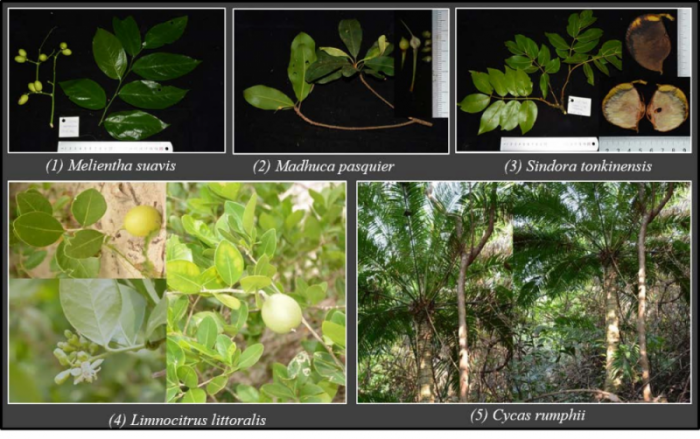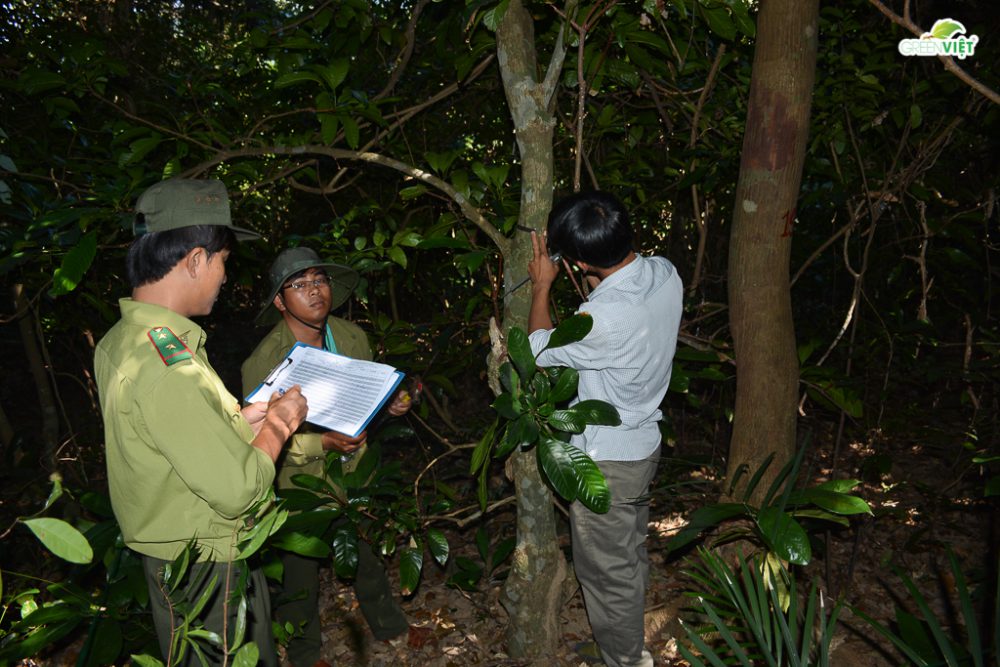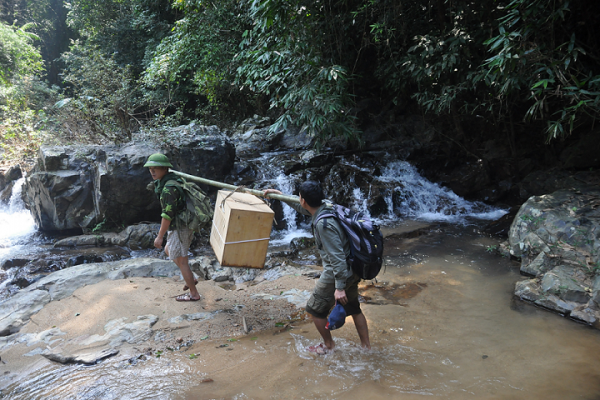FOLLOW THE FOOTSTEP OF GREENVIET’S RESEACHER TO EXPLORE BA NA FOREST
The dangerous and sheer terrain of Ba Na – Nui Chua special-use forest (SUF) has discouraged many experienced explorers for years. However, the forest’s mystery and values of biodiversity have attracted GreenViet researchers to unhesitantly throw themselves into it in order to study and do conservation work in this special forest.
For almost all ordinary people, fieldwork is without a doubt deemed frightening and hard work because of its unexpected strenuousness and dangers. Nevertheless, with Hoang Quoc Huy, an expert in the field of reptiles and amphibians of GreenViet, it is a job for life. He has spent more time doing field research in the forests than being at home with his family. In a sunny day in December 2016, Huy was again called on duty for a new task in a deserted forest.

This time, his work was to check and replace the camera traps which were set up by GreenViet in mid-2016 in Ba Na – Nui Chua forest. A camera trap is an equipment that takes photos automatically when it detects any movement or noise. To fulfill this task, Huy would have to climb up from a height of 20 m at foot of the mountain to the top at 1100 m in height and come back within only two days. Despite being familiar with forest treks, Huy’d supposed that that trip would be difficult because of precious equipment carried along with him. The reason why those camera traps are considered precious as gold is that they were filled with invaluable photos of wild animals in the deepest corners of Ba Na – Nui Chua.

Each camera trap holds an SD Card which contains thousands of photos recording any animals’ movement in front of the telescopic sight after several months silently working in the forest. These valuable photos will be used as a source of scientific evidence to determine all kinds of animals in the research area. Because of its awesome function, the camera trap always brings surprises to researchers because it is able to reveal the presence of many endangered species whose sights are rarely caught by using conventional methods (walking along a route and direct observing). Therefore, just a slip on his way coming back could easily damage these expensive devices holding a lot of important information that can not be restored by money.

After preparing food and utensils, we started the journey at 8:30 am following a forest guard. In a hurry to reach the camping area before darkness falls, we – soaked with forest sounds of birds singing and trees rustling in breezes – had to walk across babbling brooks and climb muddy, rocky, and slippery slopes for many hours.

Although our backs were bent by heavy stuff, our spirits could not be broken. Our peals of laughter and chatters that appeared to be the only human-made noise in this enormous forest fueled us with energy to overcome one slope at a time.

Terrestrial leech, a bloodsucking worm species, is very common in tropical rain forests of Viet Nam. Gloomy mountain tops of Ba Na forest make an ideal place of living for those leeches, a dozen of whom could be easily spotted in every walking step. Therefore, each of our breaks turned out to be a great opportunity for many terrestrial leeches to stick to our shoes as well as trouser legs. The worms tried to compete with each other to get the first hearty meal by slicing through our bodies. “Don’t be so tense! Let’s feed them a blood meal!” Huy joked but then calmly threw them off.
The fear of leech obsessed many of us. Following the advice of local people, we sometimes use salt, medical oil, or even fish sauce to prevent this frustrating animal. However, doing field research means signing a contract with a forest in which the obligatory clause is to devote a certain amount of blood to terrestrial leech. If one comes back from the forest without a bloody bite from the leech, one almost certainly has not walked deep enough into the forest.

Before it was getting dark, we reached the camping area next to a stream – a wonderful and convenient location for basic needs such as bathing, washing, eating, and sleeping. Each individual was responsible for different duty and we soon completed all missions. Quickly, a hut was made and a delicious meal was prepared in the middle of nowhere. Sitting on stones with legs folded, we had dinner while listening to Huy’s further explanation about the project that Greenviet has been conducting.

This is the first time GreenViet approached this new research method using camera traps. Twenty camera traps have been installed in Song Nam – Song Bac area belonging to the Management Board of Ba Na – Nui Chua SUF since May 2016. Training courses of using and operating this kind of device had been organized before that. With its ecosystem linked to the Truong Son mountain range, Ba Na – Nui Chua is considered as a place with high and unique biodiversity. It is the reason why GreenViet has a great expectation of this research program in which it can be able to support conservation work as well as provide an efficient database for science and conservation strategies.

Over thirteen thousand photos had been taken by the camera traps of GreenViet during the last year. Huy was so eager to get the camera traps back to examine the photos of wild-animals.

The next morning, the sun shined its first lights of the day through leaves that marked the next difficult phase in our journey. Being guided by GPS, we continued walking more deeply into the forest and climbing up higher to reach the locations where the camera traps had been placed.
It was really challenging for an inexperienced person like the author of this article to only remember the route and come back to the camping area. On the contrary, Huy was responsible for finding out each camera trap placed on each tree-trunk in the immense forest. Without a GPS device, he said that “seeking the exact position of a camera trap is like finding a needle in a haystack”.
Each by each, the camera traps were found by an experienced researchers with his clear distinct eyes. Contrary to normal and inexperienced people, Huy just took a glance at each tree-trunk and noticed immediately a strange object. Huy was always the first person shouting: “Oh! Here it is!” After that, the rest of the group members ran to him to check and remove the found camera trap. The pleasure of finding out camera traps has encouraged Huy to complete the mission successfully.

Most of the camera traps had been operating in months; as a result, some of them could be damaged by animals or batteries were melted or got a problem for some other reasons. Huy always carefully examined the condition of the device before continuing to seek another.

At the morning’s end, ultimately, the research group completed the mission which is to check and replace all of the camera traps of GreenViet. Worried faces disappeared and we started descending the mountain with confidence and satisfaction. Probably the three words “Come back home” sounds really warm and valuable when we have almost finished the fieldwork trip in the deep forest bathed in tears, sweats, and even blood.
It seemed that the way back home was shortened thanks to the success we got in the morning; however, it soon rained in torrents when we had been just in one-third of the way back. We all were as wet as drowned rats, so it was really difficult for us to move our heavy legs which were full of water and mud. Knees were tender when we had to walk on tiptoe across rough and slippery paths with heavy backpacks. We did not allow ourselves to have a long break because of the desire to be at home as soon as possible, as well as the fear of leeches. We quietly focused on our own footsteps. It was probably that exhaustion was having effects on us.

Any road will certainly become the pathway and any trip will surely come to an end. Finally, we reached the Forest Station of Song Bac forest. It is the place we had started our trip and also the place we said goodbye and gave thankful handshakes to other members on the trip. GreenViet wouldn’t have completed their research project without the cooperation and support of the Management Board of Ba Na – Nui Chua SUF.
With Huy, he will continue many challenging but remarkable and meaningful fieldwork missions in the future. More stories will be told for readers who love and are keen on nature like him. But now, there is nothing that matters more than coming back home and having a warm meal with family.
Nguyen Trung Hieu/ GreenViet





